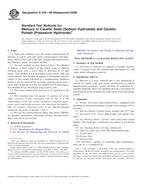Potrebujeme váš súhlas na využitie jednotlivých dát, aby sa vám okrem iného mohli ukazovať informácie týkajúce sa vašich záujmov. Súhlas udelíte kliknutím na tlačidlo „OK“.
ASTM D5544-11
Standard Test Method for On-Line Measurement of Residue After Evaporation of High-Purity Water
Automaticky preložený názov:
Štandardná skúšobná metóda pre on-line merania zvyškom po odparení z vysoko čistej vody
NORMA vydaná dňa 1.5.2011
Informácie o norme:
Označenie normy: ASTM D5544-11
Poznámka: NEPLATNÁ
Dátum vydania normy: 1.5.2011
Kód tovaru: NS-31615
Počet strán: 9
Približná hmotnosť: 27 g (0.06 libier)
Krajina: Americká technická norma
Kategória: Technické normy ASTM
Kategórie - podobné normy:
Anotácia textu normy ASTM D5544-11 :
Keywords:
high-purity water, nonvolatile residue, residue after evaporation, Colloidal dispersions, Contamination--water, Dissolved elements (of water), High-purity water, Inorganic compounds--water, Nonvolatile residue (NVR), Organic compounds--water, Residue, Residue after evaporation (RAE), Semiconductors--water applications, ICS Number Code 71.040.40 (Chemical analysis)
Doplňujúce informácie
| Significance and Use | ||||||||||||||
|
Even so-called high-purity water will contain contaminants. While not always present, these contaminants may contribute one or more of the following: dissolved active ionic substances such as calcium, magnesium, sodium, potassium, manganese, ammonium, bicarbonates, sulfates, nitrates, chloride and fluoride ions, ferric and ferrous ions, and silicates; dissolved organic substances such as pesticides, herbicides, plasticizers, styrene monomers, deionization resin material; and colloidal suspensions such as silica. While this test method facilitates the monitoring of these contaminants in high-purity water, in real time, with one instrument, this test method is not capable of identifying the various sources of residue contamination or detecting dissolved gases or suspended particles. This test method is calibrated using weighed amounts of an artificial contaminant (potassium chloride). The density of potassium chloride is reasonably typical of contaminants found in high-purity water; however, the response of this test method is clearly based on a response to potassium chloride. The response to actual contaminants found in high-purity water may differ from the test method's calibration. This test method is not different from many other analytical test methods in this respect. Together with other monitoring methods, this test method is useful for diagnosing sources of RAE in ultra-pure water systems. In particular, this test method can be used to detect leakages such as colloidal silica breakthrough from the effluent of a primary anion or mixed-bed deionizer. In addition, this test method has been used to measure the rinse-up time for new liquid filters and has been adapted for batch-type sampling (this adaptation is not described in this test method). Obtaining an immediate indication of contamination in high-purity water has significance to those industries using high-purity water for manufacturing components; production can be halted immediately to correct a contamination problem. The emerging nano-particle technology industry will also benefit from this information. |
||||||||||||||
| 1. Scope | ||||||||||||||
|
1.1 This test method covers the determination of dissolved organic and inorganic matter and colloidal material found in high-purity water used in the semiconductor, and related industries. This material is referred to as residue after evaporation (RAE). The range of the test method is from 0.001 μg/L(ppb) to 60 μg/L (ppb). 1.2 This test method uses a continuous, real time monitoring technique to measure the concentration of RAE. A pressurized sample of high-purity water is supplied to the test method's apparatus continuously through ultra-clean fittings and tubing. Contaminants from the atmosphere are therefore prevented from entering the sample. General information on the test method and a literature review on the continuous measurement of RAE has been published. 1.3 The values stated in SI units are to be regarded as the standard. The values given in parentheses are for information only. 1.4 This standard does not purport to address all of the safety concerns, if any, associated with its use. It is the responsibility of the user of this standard to establish appropriate safety and health practices and determine the applicability of regulatory limitations prior to use. For specific hazards statements, see Section 8. |
||||||||||||||
| 2. Referenced Documents | ||||||||||||||
|
Podobné normy:
Historická
15.12.2008
Historická
1.8.2013
Historická
1.6.2013
Historická
1.11.2008
Historická
1.5.2010
Historická
1.9.2008
Odporúčame:
Aktualizácia technických noriem
Chcete mať istotu, že používate len platné technické normy?
Ponúkame Vám riešenie, ktoré Vám zaistí mesačný prehľad o aktuálnosti noriem, ktoré používate.
Chcete vedieť viac informácií ? Pozrite sa na túto stránku.



 ASTM E538-98(2008)..
ASTM E538-98(2008).. ASTM F2714-08(2013)..
ASTM F2714-08(2013).. ASTM F307-13
ASTM F307-13 ASTM F327-08
ASTM F327-08 ASTM G106-89(2010)..
ASTM G106-89(2010).. ASTM G120-01(2008)..
ASTM G120-01(2008)..
 Cookies
Cookies
